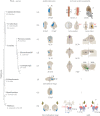Nodal signalling and asymmetry of the nervous system
- PMID: 27821531
- PMCID: PMC5104501
- DOI: 10.1098/rstb.2015.0401
Nodal signalling and asymmetry of the nervous system
Abstract
The role of Nodal signalling in nervous system asymmetry is still poorly understood. Here, we review and discuss how asymmetric Nodal signalling controls the ontogeny of nervous system asymmetry using a comparative developmental perspective. A detailed analysis of asymmetry in ascidians and fishes reveals a critical context-dependency of Nodal function and emphasizes that bilaterally paired and midline-unpaired structures/organs behave as different entities. We propose a conceptual framework to dissect the developmental function of Nodal as asymmetry inducer and laterality modulator in the nervous system, which can be used to study other types of body and visceral organ asymmetries. Using insights from developmental biology, we also present novel evolutionary hypotheses on how Nodal led the evolution of directional asymmetry in the brain, with a particular focus on the epithalamus. We intend this paper to provide a synthesis on how Nodal signalling controls left-right asymmetry of the nervous system.This article is part of the themed issue 'Provocative questions in left-right asymmetry'.
Keywords: Nodal; asymmetry; context-dependency; epithalamus; evo-devo; nervous system.
© 2016 The Author(s).
Figures






References
Publication types
MeSH terms
Substances
LinkOut - more resources
Full Text Sources
Other Literature Sources

